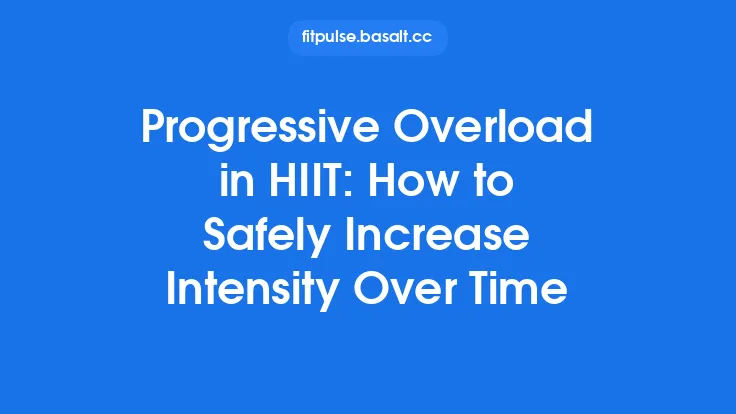Endurance athletes often wonder how to keep getting faster, farther, or longer without hitting a performance plateau. The answer lies in mastering progressive overload—the systematic, measurable increase in training stress that forces the cardiovascular and muscular systems to adapt. While the concept is simple, applying it effectively to endurance workouts requires a clear understanding of the variables you can manipulate, the physiological responses they trigger, and the practical tools you need to track progress. This guide walks you through the science and the step‑by‑step process of structuring progressive overload in endurance training, giving you a reliable framework you can adapt to running, cycling, swimming, or any other aerobic discipline.
Understanding the Core Variables of Endurance Overload
Endurance performance is shaped by four primary training variables:
| Variable | What It Represents | Typical Manipulation Methods |
|---|---|---|
| Duration | Total time spent exercising in a session (e.g., 60‑min run) | Add minutes, extend long‑run distance, increase total weekly hours |
| Intensity | Relative effort level, often expressed as % of VO₂max, heart‑rate zones, or power output | Raise target zone, increase pace, add faster intervals |
| Frequency | Number of training sessions per week | Add an extra day, insert a recovery ride/run, split a long session into two |
| Modality/Complexity | Type of effort (steady‑state, interval, hill, tempo) and technical demands | Introduce intervals, add hill repeats, incorporate mixed‑terrain runs |
Progressive overload can be applied to any one of these variables, but the most sustainable gains usually come from small, concurrent adjustments across several dimensions rather than a single, dramatic jump. For example, adding 5 minutes to a long run while slightly increasing the average pace and inserting a short interval block creates a balanced stimulus that promotes both aerobic capacity and muscular endurance.
Principles of Progressive Overload for the Cardiovascular System
- Specificity – The overload must mirror the demands of your target event. A marathoner will prioritize long, steady‑state volume, whereas a criterium cyclist will focus on high‑intensity intervals.
- Progression – Increments should be gradual (typically 5‑10 % per week) to allow the heart, capillary network, and mitochondrial density to adapt without excessive strain.
- Individualization – Baseline fitness, age, training history, and genetics dictate how quickly you can safely increase load. Use objective markers (e.g., heart‑rate variability, lactate threshold) to tailor progression.
- Recovery – Adaptations occur during rest. Adequate sleep, nutrition, and low‑intensity days are integral to the overload–recovery cycle.
- Reversibility – Detraining can erode gains quickly, especially in endurance. Maintaining a minimum “maintenance” volume prevents backsliding during off‑season or injury periods.
Designing Incremental Increases: Duration, Intensity, and Frequency
1. Linear Progression (Classic 5‑10 % Rule)
- Duration: Add 5–10 % to the longest weekly session.
- Example: 90‑min long run → 95‑min next week.
- Intensity: Raise target heart‑rate zone by 2–3 bpm or increase power by 5 W.
- Frequency: Insert an extra easy day after a 2‑week block of steady training.
2. Undulating (Non‑Linear) Progression
- Rotate focus each week:
- Week 1 – Volume ↑, intensity steady.
- Week 2 – Intensity ↑, volume steady.
- Week 3 – Recovery (volume ↓, intensity ↓).
- This pattern reduces monotony and mitigates overuse injuries while still delivering progressive stress.
3. Step‑Loading (Micro‑Blocks)
- Use 3‑week micro‑blocks: two weeks of gradual increase followed by a “step” week where load is held constant or slightly reduced to consolidate adaptations.
- Particularly useful for athletes juggling multiple modalities (e.g., triathletes) because it provides a built‑in “reset” without a full deload.
Applying Overload Through Different Endurance Modalities
| Modality | Primary Variable to Manipulate | Sample Overload Strategies |
|---|---|---|
| Steady‑State Running | Duration & Pace | Increase weekly long‑run distance by 1 km; add 10‑second per km pace increments every 2 weeks. |
| Cycling (Road/TT) | Power & Cadence | Raise FTP‑based intervals by 5 W; add 2‑minute high‑cadence bursts within a 30‑min tempo ride. |
| Swimming | Stroke Count & Interval Length | Extend each interval by 25 m; add a second set of 200 m repeats at a slightly faster pace. |
| Trail/Hill Running | Elevation & Technical Effort | Add 50 m of cumulative ascent per week; incorporate a new hill repeat set every 3 weeks. |
| Rowing (Ergometer) | Split Time & Volume | Reduce 500‑m split by 2 seconds; add an extra 5‑minute row to the weekly total. |
Key Insight: The type of overload you choose should reflect the dominant energy system of the activity. For ultra‑distance events, volume dominates; for middle‑distance races, intensity (lactate threshold) is paramount.
Monitoring Adaptations and Adjusting the Load
- Objective Metrics
- Heart‑Rate Variability (HRV): Declines >10 % over 3 consecutive days may signal insufficient recovery.
- Training Impulse (TRIMP): Calculate using duration × HR zone weighting; aim for a 5‑10 % weekly increase.
- Power/Speed Thresholds: Re‑test FTP, VT2, or 5‑km pace every 4–6 weeks to recalibrate zones.
- Subjective Metrics
- Rate of Perceived Exertion (RPE): Track session RPE; a steady rise at the same workload indicates accumulating fatigue.
- Wellness Questionnaires: Sleep quality, muscle soreness, and mood scores help fine‑tune progression.
- Adjustment Rules
- If objective load ↑ and performance ↑ → Continue progression.
- If load ↑ but performance plateaus or declines → Reduce intensity or volume by 10 % for the next week.
- If wellness scores dip → Insert an extra recovery day or replace a hard session with an easy cross‑train.
Common Pitfalls and How to Avoid Overtraining
| Pitfall | Why It Happens | Prevention Strategy |
|---|---|---|
| Increasing One Variable Too Fast | Over‑reliance on “just add 10 minutes” without considering intensity. | Use the 5‑10 % rule across all variables; keep a log of weekly total load. |
| Neglecting Recovery Days | “More is better” mindset. | Schedule at least one full rest day and two easy days per week; use HRV to confirm readiness. |
| Ignoring Individual Limits | Copy‑pasting generic plans. | Conduct baseline testing (VO₂max, lactate threshold) and adjust progression based on personal data. |
| Failing to Periodically Reset | Continuous overload leads to diminishing returns. | Implement step‑loading or undulating cycles; plan a “recovery week” every 4–6 weeks. |
| Over‑Emphasizing Pace/Power Numbers | Fixation on numbers can mask fatigue. | Pair performance metrics with RPE and wellness scores for a holistic view. |
Sample Progressive Overload Templates
1. 8‑Week Running Progression (Half‑Marathon Focus)
| Week | Long Run (km) | Mid‑Week Tempo (km) | Easy Runs (km) | Weekly Total (km) | Key Overload |
|---|---|---|---|---|---|
| 1 | 12 | 8 @ 85 % HRmax | 2 × 5 | 30 | Baseline |
| 2 | 13 (+8 %) | 8 | 2 × 5 | 31 | +1 km long |
| 3 | 14 (+8 %) | 9 (+12 %) | 2 × 5 | 33 | +1 km long, +1 km tempo |
| 4 | 12 (Recovery) | 8 | 2 × 5 | 30 | Load reduction |
| 5 | 15 (+25 %) | 9 | 2 × 5 | 34 | +1 km long |
| 6 | 16 (+7 %) | 10 (+11 %) | 2 × 5 | 36 | +1 km long, +1 km tempo |
| 7 | 17 (+6 %) | 10 | 2 × 5 | 37 | +1 km long |
| 8 | 18 (+6 %) | 11 (+10 %) | 2 × 5 | 39 | Peak week |
Note: Weeks 4 and 8 can be followed by a 2‑week taper before race day.
2. 6‑Week Cycling FTP‑Based Overload
| Week | FTP Intervals (min) | Power (W) | Total High‑Intensity Time (min) | Recovery Rides (h) | Weekly Load (TRIMP) |
|---|---|---|---|---|---|
| 1 | 2 × 10 | 250 (100 % FTP) | 20 | 3 × 1.5 | 450 |
| 2 | 2 × 12 | 250 | 24 | 3 × 1.5 | 540 |
| 3 | 3 × 10 | 255 (102 % FTP) | 30 | 2 × 2 | 600 |
| 4 | 3 × 12 | 255 | 36 | 2 × 2 | 720 |
| 5 | 4 × 10 | 260 (104 % FTP) | 40 | 2 × 2 | 800 |
| 6 | 4 × 12 | 260 | 48 | 1 × 2 | 960 |
Progression: +2 min interval length each week, +5 W power every two weeks, and a modest increase in total high‑intensity minutes.
Integrating Overload Within a Periodized Framework
While this article does not delve into full macro‑cycle periodization, it is useful to see how progressive overload fits into meso‑cycle blocks (typically 3–6 weeks).
- Base Block (Weeks 1‑4) – Emphasize volume overload with low‑intensity work.
- Build Block (Weeks 5‑8) – Shift the overload toward intensity (threshold and VO₂max intervals) while maintaining a slightly reduced volume.
- Peak Block (Weeks 9‑12) – Fine‑tune race‑specific intensity, using smaller, high‑quality overloads and more frequent recovery weeks.
Within each block, apply the linear, undulating, or step‑loading patterns described earlier. The key is that overload is the engine, while the block structure provides the roadmap for when to change the primary variable.
Tools and Technologies to Support Overload Tracking
| Tool | Primary Use | How It Helps With Overload |
|---|---|---|
| Garmin/Polar HR Monitors | Continuous heart‑rate and HRV | Detects early signs of fatigue; validates intensity zones. |
| Power Meters (Bike, Rowing) | Objective power output | Quantifies intensity increments; calculates TRIMP precisely. |
| GPS/Strava | Distance, pace, elevation | Tracks duration and volume; visualizes weekly mileage trends. |
| TrainingPeaks | Structured workout planning | Allows you to assign target TSS (Training Stress Score) and monitor weekly load. |
| Wearable Sleep Trackers | Sleep quantity/quality | Correlates recovery metrics with overload decisions. |
| Excel/Google Sheets | Custom logs | Enables you to calculate % changes, plot trends, and set alerts for excessive load spikes. |
When using technology, consistency beats sophistication. A simple spreadsheet that records weekly mileage, average heart‑rate zone, and RPE can be as powerful as a premium platform, provided you review it regularly.
Putting It All Together: A Practical Checklist
- [ ] Baseline Test: Determine VO₂max, lactate threshold, or FTP.
- [ ] Choose Primary Overload Variable: Duration for ultra‑distance, intensity for middle‑distance, or a blend for mixed events.
- [ ] Set Incremental Targets: 5‑10 % weekly increase, or follow an undulating schedule.
- [ ] Schedule Recovery: At least one full rest day + two easy days per week.
- [ ] Track Objective Data: HRV, TRIMP, power/pace, and weekly totals.
- [ ] Log Subjective Data: RPE, sleep, soreness, mood.
- [ ] Review Weekly: Compare load vs. performance; adjust the next week’s plan accordingly.
- [ ] Plan a Reset: Every 4–6 weeks, reduce load by 10‑20 % to consolidate gains.
By systematically applying these steps, you create a self‑regulating loop where overload drives adaptation, monitoring informs adjustments, and recovery cements the gains. The result is a sustainable, evidence‑based pathway to faster race times, longer training sessions, and a healthier cardiovascular system.
Bottom line: Progressive overload is not a one‑size‑fits‑all prescription; it is a dynamic, data‑driven process that respects the individual athlete’s physiology, goals, and life circumstances. Master the variables, monitor intelligently, and adjust deliberately, and you’ll keep moving the finish line farther away—while staying stronger, faster, and healthier.





